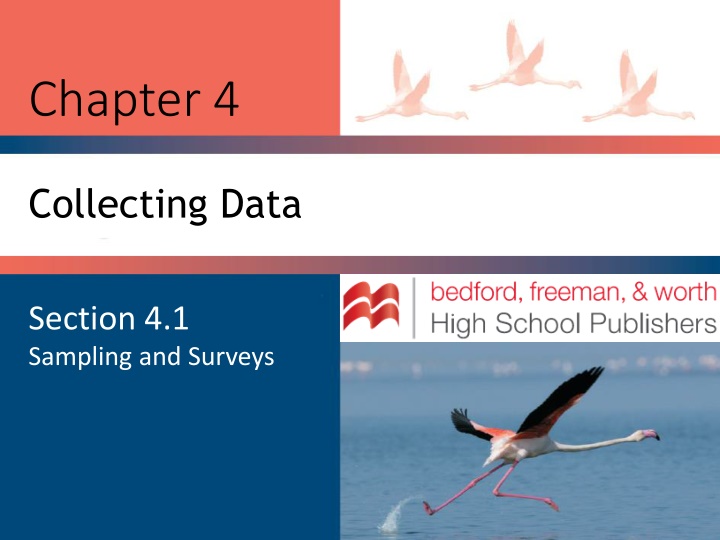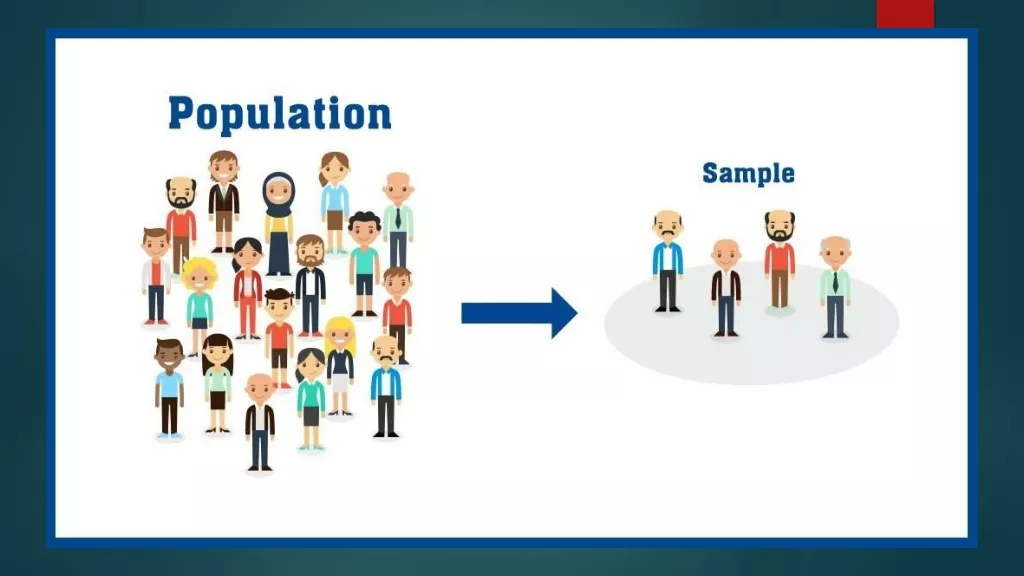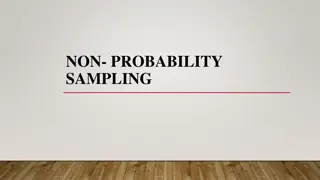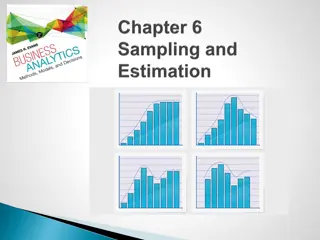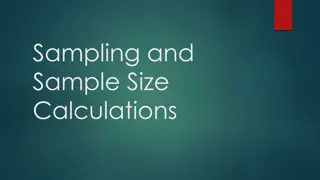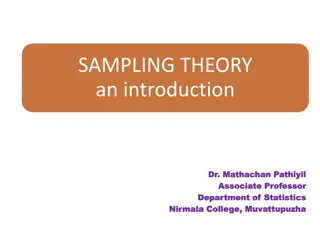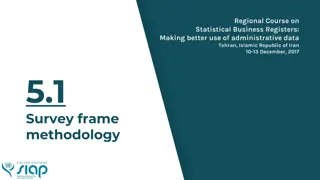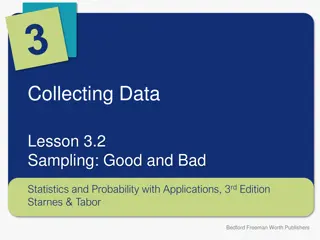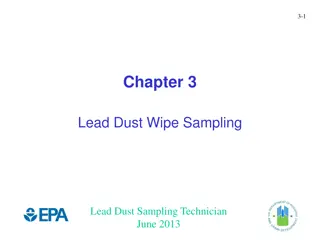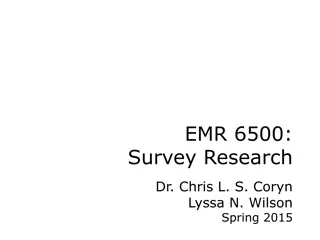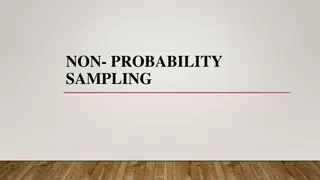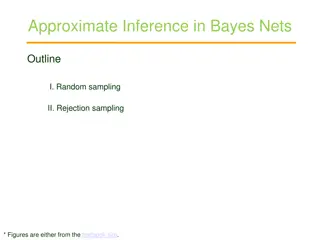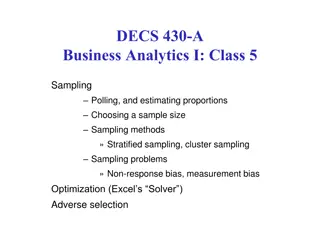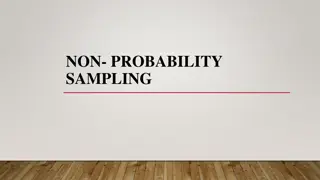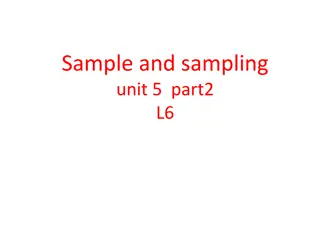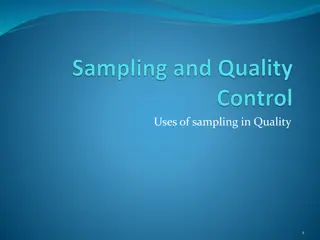Sampling and Surveys: Understanding Population and Sample
In statistics, understanding the population and sample is crucial. Learn about different sampling methods, such as voluntary response and convenience sampling, and how they can introduce bias. Explore techniques like simple random sampling, stratified random sampling, and cluster sampling. Discover how factors like undercoverage, nonresponse, and question wording can affect survey results. Dive into the concepts of population, census, and sample to enhance your statistical knowledge.
Download Presentation

Please find below an Image/Link to download the presentation.
The content on the website is provided AS IS for your information and personal use only. It may not be sold, licensed, or shared on other websites without obtaining consent from the author.If you encounter any issues during the download, it is possible that the publisher has removed the file from their server.
You are allowed to download the files provided on this website for personal or commercial use, subject to the condition that they are used lawfully. All files are the property of their respective owners.
The content on the website is provided AS IS for your information and personal use only. It may not be sold, licensed, or shared on other websites without obtaining consent from the author.
E N D
Presentation Transcript
Chapter 4 Collecting Data Section 4.1 Sampling and Surveys
Sampling and Surveys LEARNING TARGETS By the end of this section, you should be able to: IDENTIFY the population and sample in a statistical study. IDENTIFY voluntary response sampling and convenience sampling and EXPLAIN how these sampling methods can lead to bias. DESCRIBE how to select a simple random sample with technology or a table of random digits. DESCRIBE how to select a sample using stratified random sampling and cluster sampling, DISTINGUISH stratified random sampling from cluster sampling, and GIVE an advantage of each method. EXPLAIN how undercoverage, nonresponse, question wording, and other aspects of a sample survey can lead to bias. Starnes/Tabor, The Practice of Statistics
Population, Census, and Sample The population in a statistical study is the entire group of individuals we want information about. Starnes/Tabor, The Practice of Statistics
Population, Census, and Sample The population in a statistical study is the entire group of individuals we want information about. A census collects data from every individual in the population. Starnes/Tabor, The Practice of Statistics
Population, Census, and Sample The population in a statistical study is the entire group of individuals we want information about. A census collects data from every individual in the population. A sample is a subset of individuals in the population from which we actually collect data. Starnes/Tabor, The Practice of Statistics
Population, Census, and Sample The population in a statistical study is the entire group of individuals we want information about. A census collects data from every individual in the population. A sample is a subset of individuals in the population from which we actually collect data. Population Starnes/Tabor, The Practice of Statistics
Population, Census, and Sample The population in a statistical study is the entire group of individuals we want information about. A census collects data from every individual in the population. A sample is a subset of individuals in the population from which we actually collect data. Population Sample Starnes/Tabor, The Practice of Statistics
Population, Census, and Sample The population in a statistical study is the entire group of individuals we want information about. A census collects data from every individual in the population. A sample is a subset of individuals in the population from which we actually collect data. Population Collect data from a representative sample... Sample Starnes/Tabor, The Practice of Statistics
Population, Census, and Sample The population in a statistical study is the entire group of individuals we want information about. A census collects data from every individual in the population. A sample is a subset of individuals in the population from which we actually collect data. Population Collect data from a representative sample... Sample Make an inference about the population. Starnes/Tabor, The Practice of Statistics
The Idea of a Sample Survey We often draw conclusions about a whole population on the basis of a sample. Choosing a sample from a large, varied population is not that easy. Starnes/Tabor, The Practice of Statistics
The Idea of a Sample Survey We often draw conclusions about a whole population on the basis of a sample. Choosing a sample from a large, varied population is not that easy. A sample survey is a study that collects data from a sample that is chosen to represent a specific population. Starnes/Tabor, The Practice of Statistics
The Idea of a Sample Survey We often draw conclusions about a whole population on the basis of a sample. Choosing a sample from a large, varied population is not that easy. A sample survey is a study that collects data from a sample that is chosen to represent a specific population. Planning a Sample Survey Decide what population we want to describe. Decide what we want to measure. Decide how to choose a sample from the population. 1. 2. 3. Starnes/Tabor, The Practice of Statistics
How to Sample Badly Choosing individuals from the population who are easy to reach results in a convenience sample. Starnes/Tabor, The Practice of Statistics
How to Sample Badly Choosing individuals from the population who are easy to reach results in a convenience sample. CAUTION: Convenience sampling often produces unrepresentative data. Starnes/Tabor, The Practice of Statistics
How to Sample Badly Choosing individuals from the population who are easy to reach results in a convenience sample. CAUTION: Convenience sampling often produces unrepresentative data. The design of a statistical study shows bias if it is very likely to underestimate or very likely to overestimate the value you want to know. Starnes/Tabor, The Practice of Statistics
How to Sample Badly Choosing individuals from the population who are easy to reach results in a convenience sample. CAUTION: Convenience sampling often produces unrepresentative data. The design of a statistical study shows bias if it is very likely to underestimate or very likely to overestimate the value you want to know. CAUTION: Bias is not just bad luck in one sample. Starnes/Tabor, The Practice of Statistics
How to Sample Badly Convenience sampling will almost always result in bias. But so will some other sampling methods. Starnes/Tabor, The Practice of Statistics
How to Sample Badly Convenience sampling will almost always result in bias. But so will some other sampling methods. Voluntary response sampling allows people to choose to be in the sample by responding to a general invitation. Starnes/Tabor, The Practice of Statistics
How to Sample Badly Convenience sampling will almost always result in bias. But so will some other sampling methods. Voluntary response sampling allows people to choose to be in the sample by responding to a general invitation. Most Internet polls, along with call-in, text-in, and write-in polls, rely on voluntary response sampling. People who self- select to participate in such surveys are usually not representative of some larger population of interest. Starnes/Tabor, The Practice of Statistics
How to Sample Well: Simple Random Sampling A sample chosen by chance rules out both favoritism by the sampler and self-selection by respondents. Starnes/Tabor, The Practice of Statistics
How to Sample Well: Simple Random Sampling A sample chosen by chance rules out both favoritism by the sampler and self-selection by respondents. Random sampling involves using a chance process to determine which members of a population are included in the sample. Starnes/Tabor, The Practice of Statistics
How to Sample Well: Simple Random Sampling A sample chosen by chance rules out both favoritism by the sampler and self-selection by respondents. Random sampling involves using a chance process to determine which members of a population are included in the sample. A simple random sample (SRS) of size n is chosen in such a way that every group of n individuals in the population has an equal chance to be selected as the sample. Starnes/Tabor, The Practice of Statistics
How to Choose an SRS How to Choose an SRS with Technology Label. Give each individual in the population a distinct numerical label from 1 to N, where N is the number of individuals in the population. Starnes/Tabor, The Practice of Statistics
How to Choose an SRS How to Choose an SRS with Technology Label. Give each individual in the population a distinct numerical label from 1 to N, where N is the number of individuals in the population. Randomize. Use a random number generator to obtain n different integers from 1 to N, where n is the sample size. Starnes/Tabor, The Practice of Statistics
How to Choose an SRS How to Choose an SRS with Technology Label. Give each individual in the population a distinct numerical label from 1 to N, where N is the number of individuals in the population. Randomize. Use a random number generator to obtain n different integers from 1 to N, where n is the sample size. Select. Choose the individuals that correspond to the randomly selected integers. Starnes/Tabor, The Practice of Statistics
How to Choose an SRS How to Choose an SRS with Technology Label. Give each individual in the population a distinct numerical label from 1 to N, where N is the number of individuals in the population. Randomize. Use a random number generator to obtain n different integers from 1 to N, where n is the sample size. Select. Choose the individuals that correspond to the randomly selected integers. How to Choose an SRS with Table D Label. Give each member of the population a distinct numerical label with the same number of digits. Use as few digits as possible. Starnes/Tabor, The Practice of Statistics
How to Choose an SRS How to Choose an SRS with Technology Label. Give each individual in the population a distinct numerical label from 1 to N, where N is the number of individuals in the population. Randomize. Use a random number generator to obtain n different integers from 1 to N, where n is the sample size. Select. Choose the individuals that correspond to the randomly selected integers. How to Choose an SRS with Table D Label. Give each member of the population a distinct numerical label with the same number of digits. Use as few digits as possible. Randomize. Read consecutive groups of digits of the appropriate length from left to right across a line in Table D. Ignore any group of digits that wasn t used as a label or that duplicates a label already in the sample. Stop when you have chosen n different labels. Starnes/Tabor, The Practice of Statistics
How to Choose an SRS How to Choose an SRS with Technology Label. Give each individual in the population a distinct numerical label from 1 to N, where N is the number of individuals in the population. Randomize. Use a random number generator to obtain n different integers from 1 to N, where n is the sample size. Select. Choose the individuals that correspond to the randomly selected integers. How to Choose an SRS with Table D Label. Give each member of the population a distinct numerical label with the same number of digits. Use as few digits as possible. Randomize. Read consecutive groups of digits of the appropriate length from left to right across a line in Table D. Ignore any group of digits that wasn t used as a label or that duplicates a label already in the sample. Stop when you have chosen n different labels. Select. Choose the individuals that correspond to the randomly selected integers. Starnes/Tabor, The Practice of Statistics
How to Choose an SRS Use line 130 of Table D to choose an SRS of 4 hotels. 01 Aloha Kai 02 Anchor Down 03 Banana Bay 04 Banyan Tree 05 Beach Castle 06 Best Western 07 Cabana 08 Captiva 09 Casa del Mar 10 Coconuts 11 Diplomat 12 Holiday Inn 13 Lime Tree 14 Outrigger 15 Palm Tree 16 Radisson 17 Ramada 18 Sandpiper 19 Sea Castle 20 Sea Club 21 Sea Grape 22 Sea Shell 23 Silver Beach 24 Sunset Beach 25 Tradewinds 26 Tropical Breeze 27 Tropical Shores 28 Veranda Starnes/Tabor, The Practice of Statistics
How to Choose an SRS Use line 130 of Table D to choose an SRS of 4 hotels. 01 Aloha Kai 02 Anchor Down 03 Banana Bay 04 Banyan Tree 05 Beach Castle 06 Best Western 07 Cabana 08 Captiva 09 Casa del Mar 10 Coconuts 11 Diplomat 12 Holiday Inn 13 Lime Tree 14 Outrigger 15 Palm Tree 16 Radisson 17 Ramada 18 Sandpiper 19 Sea Castle 20 Sea Club 21 Sea Grape 22 Sea Shell 23 Silver Beach 24 Sunset Beach 25 Tradewinds 26 Tropical Breeze 27 Tropical Shores 28 Veranda 69051 64817 87174 0951784534 06489 87201 97245 Starnes/Tabor, The Practice of Statistics
How to Choose an SRS Use line 130 of Table D to choose an SRS of 4 hotels. 01 Aloha Kai 02 Anchor Down 03 Banana Bay 04 Banyan Tree 05 Beach Castle 06 Best Western 07 Cabana 08 Captiva 09 Casa del Mar 10 Coconuts 11 Diplomat 12 Holiday Inn 13 Lime Tree 14 Outrigger 15 Palm Tree 16 Radisson 17 Ramada 18 Sandpiper 19 Sea Castle 20 Sea Club 21 Sea Grape 22 Sea Shell 23 Silver Beach 24 Sunset Beach 25 Tradewinds 26 Tropical Breeze 27 Tropical Shores 28 Veranda 69051 64817 87174 0951784534 06489 87201 97245 69 05 16 48 17 87 17 40 95 17 84 53 40 64 89 87 20 Starnes/Tabor, The Practice of Statistics
How to Choose an SRS Use line 130 of Table D to choose an SRS of 4 hotels. 01 Aloha Kai 02 Anchor Down 03 Banana Bay 04 Banyan Tree 05 Beach Castle 06 Best Western 07 Cabana 08 Captiva 09 Casa del Mar 10 Coconuts 11 Diplomat 12 Holiday Inn 13 Lime Tree 14 Outrigger 15 Palm Tree 16 Radisson 17 Ramada 18 Sandpiper 19 Sea Castle 20 Sea Club 21 Sea Grape 22 Sea Shell 23 Silver Beach 24 Sunset Beach 25 Tradewinds 26 Tropical Breeze 27 Tropical Shores 28 Veranda 69051 64817 87174 0951784534 06489 87201 97245 69 05 16 48 17 87 17 40 95 17 84 53 40 64 89 87 20 Starnes/Tabor, The Practice of Statistics
How to Choose an SRS Use line 130 of Table D to choose an SRS of 4 hotels. 01 Aloha Kai 02 Anchor Down 03 Banana Bay 04 Banyan Tree 05 Beach Castle 06 Best Western 07 Cabana 08 Captiva 09 Casa del Mar 10 Coconuts 11 Diplomat 12 Holiday Inn 13 Lime Tree 14 Outrigger 15 Palm Tree 16 Radisson 17 Ramada 18 Sandpiper 19 Sea Castle 20 Sea Club 21 Sea Grape 22 Sea Shell 23 Silver Beach 24 Sunset Beach 25 Tradewinds 26 Tropical Breeze 27 Tropical Shores 28 Veranda 69051 64817 87174 0951784534 06489 87201 97245 69 05 16 48 17 87 17 40 95 17 84 53 40 64 89 87 20 Starnes/Tabor, The Practice of Statistics
How to Choose an SRS Use line 130 of Table D to choose an SRS of 4 hotels. 01 Aloha Kai 02 Anchor Down 03 Banana Bay 04 Banyan Tree 05 Beach Castle 06 Best Western 07 Cabana 08 Captiva 09 Casa del Mar 10 Coconuts 11 Diplomat 12 Holiday Inn 13 Lime Tree 14 Outrigger 15 Palm Tree 16 Radisson 17 Ramada 18 Sandpiper 19 Sea Castle 20 Sea Club 21 Sea Grape 22 Sea Shell 23 Silver Beach 24 Sunset Beach 25 Tradewinds 26 Tropical Breeze 27 Tropical Shores 28 Veranda 69051 64817 87174 0951784534 06489 87201 97245 69 05 16 48 17 87 17 40 95 17 84 53 40 64 89 87 20 Starnes/Tabor, The Practice of Statistics
How to Choose an SRS Use line 130 of Table D to choose an SRS of 4 hotels. 01 Aloha Kai 02 Anchor Down 03 Banana Bay 04 Banyan Tree 05 Beach Castle 06 Best Western 07 Cabana 08 Captiva 09 Casa del Mar 10 Coconuts 11 Diplomat 12 Holiday Inn 13 Lime Tree 14 Outrigger 15 Palm Tree 16 Radisson 17 Ramada 18 Sandpiper 19 Sea Castle 20 Sea Club 21 Sea Grape 22 Sea Shell 23 Silver Beach 24 Sunset Beach 25 Tradewinds 26 Tropical Breeze 27 Tropical Shores 28 Veranda 69051 64817 87174 0951784534 06489 87201 97245 69 05 16 48 17 87 17 40 95 17 84 53 40 64 89 87 20 Starnes/Tabor, The Practice of Statistics
How to Choose an SRS Use line 130 of Table D to choose an SRS of 4 hotels. 01 Aloha Kai 02 Anchor Down 03 Banana Bay 04 Banyan Tree 05 Beach Castle 06 Best Western 07 Cabana 08 Captiva 09 Casa del Mar 10 Coconuts 11 Diplomat 12 Holiday Inn 13 Lime Tree 14 Outrigger 15 Palm Tree 16 Radisson 17 Ramada 18 Sandpiper 19 Sea Castle 20 Sea Club 21 Sea Grape 22 Sea Shell 23 Silver Beach 24 Sunset Beach 25 Tradewinds 26 Tropical Breeze 27 Tropical Shores 28 Veranda 69051 64817 87174 0951784534 06489 87201 97245 69 05 16 48 17 87 17 40 95 17 84 53 40 64 89 87 20 Starnes/Tabor, The Practice of Statistics
How to Choose an SRS Use line 130 of Table D to choose an SRS of 4 hotels. 01 Aloha Kai 02 Anchor Down 03 Banana Bay 04 Banyan Tree 05 Beach Castle 06 Best Western 07 Cabana 08 Captiva 09 Casa del Mar 10 Coconuts 11 Diplomat 12 Holiday Inn 13 Lime Tree 14 Outrigger 15 Palm Tree 16 Radisson 17 Ramada 18 Sandpiper 19 Sea Castle 20 Sea Club 21 Sea Grape 22 Sea Shell 23 Silver Beach 24 Sunset Beach 25 Tradewinds 26 Tropical Breeze 27 Tropical Shores 28 Veranda 69051 64817 87174 0951784534 06489 87201 97245 69 05 16 48 17 87 17 40 95 17 84 53 40 64 89 87 20 Starnes/Tabor, The Practice of Statistics
How to Choose an SRS Use line 130 of Table D to choose an SRS of 4 hotels. 01 Aloha Kai 02 Anchor Down 03 Banana Bay 04 Banyan Tree 05 Beach Castle 06 Best Western 07 Cabana 08 Captiva 09 Casa del Mar 10 Coconuts 11 Diplomat 12 Holiday Inn 13 Lime Tree 14 Outrigger 15 Palm Tree 16 Radisson 17 Ramada 18 Sandpiper 19 Sea Castle 20 Sea Club 21 Sea Grape 22 Sea Shell 23 Silver Beach 24 Sunset Beach 25 Tradewinds 26 Tropical Breeze 27 Tropical Shores 28 Veranda 69051 64817 87174 0951784534 06489 87201 97245 69 05 16 48 17 87 17 40 95 17 84 53 40 64 89 87 20 Starnes/Tabor, The Practice of Statistics
How to Choose an SRS Use line 130 of Table D to choose an SRS of 4 hotels. 01 Aloha Kai 02 Anchor Down 03 Banana Bay 04 Banyan Tree 05 Beach Castle 06 Best Western 07 Cabana 08 Captiva 09 Casa del Mar 10 Coconuts 11 Diplomat 12 Holiday Inn 13 Lime Tree 14 Outrigger 15 Palm Tree 16 Radisson 17 Ramada 18 Sandpiper 19 Sea Castle 20 Sea Club 21 Sea Grape 22 Sea Shell 23 Silver Beach 24 Sunset Beach 25 Tradewinds 26 Tropical Breeze 27 Tropical Shores 28 Veranda 69051 64817 87174 0951784534 06489 87201 97245 69 05 16 48 17 87 17 40 95 17 84 53 40 64 89 87 20 Starnes/Tabor, The Practice of Statistics
How to Choose an SRS Use line 130 of Table D to choose an SRS of 4 hotels. 01 Aloha Kai 02 Anchor Down 03 Banana Bay 04 Banyan Tree 05 Beach Castle 06 Best Western 07 Cabana 08 Captiva 09 Casa del Mar 10 Coconuts 11 Diplomat 12 Holiday Inn 13 Lime Tree 14 Outrigger 15 Palm Tree 16 Radisson 17 Ramada 18 Sandpiper 19 Sea Castle 20 Sea Club 21 Sea Grape 22 Sea Shell 23 Silver Beach 24 Sunset Beach 25 Tradewinds 26 Tropical Breeze 27 Tropical Shores 28 Veranda 69051 64817 87174 0951784534 06489 87201 97245 69 05 16 48 17 87 17 40 95 17 84 53 40 64 89 87 20 Our SRS of 4 hotels is: 05 Beach Castle, 16 Radisson, 17 Ramada, and 20 Sea Club. Starnes/Tabor, The Practice of Statistics
Other Sampling Methods One of the most common alternatives to simple random sampling is called stratified random sampling. Starnes/Tabor, The Practice of Statistics
Other Sampling Methods One of the most common alternatives to simple random sampling is called stratified random sampling. Strata are groups of individuals in a population who share characteristics thought to be associated with the variables being measured in a study. Stratified random sampling selects a sample by choosing an SRS from each stratum and combining the SRSs into one overall sample. Starnes/Tabor, The Practice of Statistics
Other Sampling Methods One of the most common alternatives to simple random sampling is called stratified random sampling. Strata are groups of individuals in a population who share characteristics thought to be associated with the variables being measured in a study. Stratified random sampling selects a sample by choosing an SRS from each stratum and combining the SRSs into one overall sample. Stratified random sampling works best when the individuals within each stratum are similar with respect to what is being measured and when there are large differences between strata. Starnes/Tabor, The Practice of Statistics
Other Sampling Methods One of the most common alternatives to simple random sampling is called stratified random sampling. Strata are groups of individuals in a population who share characteristics thought to be associated with the variables being measured in a study. Stratified random sampling selects a sample by choosing an SRS from each stratum and combining the SRSs into one overall sample. Stratified random sampling works best when the individuals within each stratum are similar with respect to what is being measured and when there are large differences between strata. When we can choose strata that have similar responses within strata but different responses between strata, stratified random samples give more precise estimates than simple random samples of the same size. Starnes/Tabor, The Practice of Statistics
Other Sampling Methods When populations are large and spread out over a wide area, we d prefer a method that selects groups (clusters) of individuals that are near one another. That s the idea of cluster sampling. Starnes/Tabor, The Practice of Statistics
Other Sampling Methods When populations are large and spread out over a wide area, we d prefer a method that selects groups (clusters) of individuals that are near one another. That s the idea of cluster sampling. A cluster is a group of individuals in the population that are located near each other. Cluster sampling selects a sample by randomly choosing clusters and including each member of the selected clusters in the sample. Starnes/Tabor, The Practice of Statistics
Other Sampling Methods When populations are large and spread out over a wide area, we d prefer a method that selects groups (clusters) of individuals that are near one another. That s the idea of cluster sampling. A cluster is a group of individuals in the population that are located near each other. Cluster sampling selects a sample by randomly choosing clusters and including each member of the selected clusters in the sample. Cluster sampling works best when the clusters look just like the population but on a smaller scale. Starnes/Tabor, The Practice of Statistics
Other Sampling Methods When populations are large and spread out over a wide area, we d prefer a method that selects groups (clusters) of individuals that are near one another. That s the idea of cluster sampling. A cluster is a group of individuals in the population that are located near each other. Cluster sampling selects a sample by randomly choosing clusters and including each member of the selected clusters in the sample. Cluster sampling works best when the clusters look just like the population but on a smaller scale. Cluster sampling is often used for practical reasons, like saving time and money. Starnes/Tabor, The Practice of Statistics
Sample Surveys: What Can Go Wrong? As we have learned, the use of bad sampling methods (convenience or voluntary response) often leads to bias. Researchers can avoid these methods by using random sampling to choose their samples. Other problems in conducting sample surveys are more difficult to avoid. Starnes/Tabor, The Practice of Statistics
Sample Surveys: What Can Go Wrong? As we have learned, the use of bad sampling methods (convenience or voluntary response) often leads to bias. Researchers can avoid these methods by using random sampling to choose their samples. Other problems in conducting sample surveys are more difficult to avoid. Undercoverage occurs when some members of the population are less likely to be chosen or cannot be chosen in a sample. Starnes/Tabor, The Practice of Statistics
